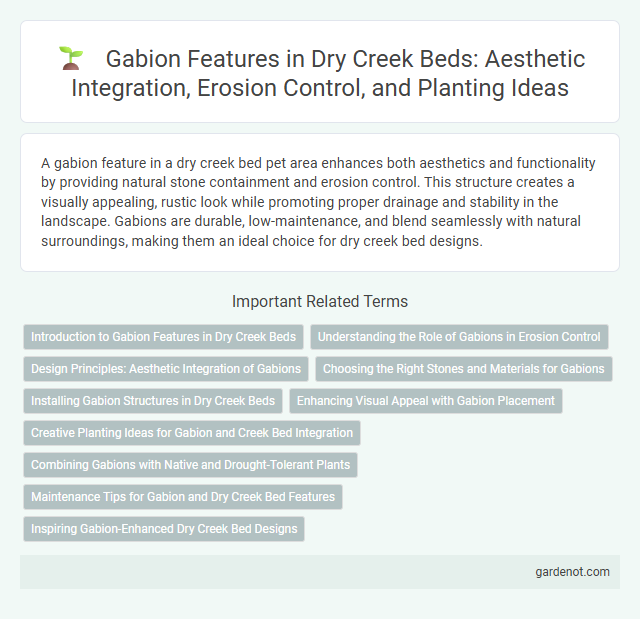A gabion feature in a dry creek bed pet area enhances both aesthetics and functionality by providing natural stone containment and erosion control. This structure creates a visually appealing, rustic look while promoting proper drainage and stability in the landscape. Gabions are durable, low-maintenance, and blend seamlessly with natural surroundings, making them an ideal choice for dry creek bed designs.
Introduction to Gabion Features in Dry Creek Beds
Gabions in dry creek beds serve as essential erosion control structures composed of wire mesh cages filled with rocks or other durable materials. These features stabilize soil, reduce water flow speed, and promote sediment deposition, thereby preventing channel degradation. Their porous nature allows water to pass through while trapping debris, making gabions an effective, sustainable solution for managing dry creek bed environments.
Understanding the Role of Gabions in Erosion Control
Gabions are wire mesh containers filled with rocks or stones, designed to stabilize dry creek beds by controlling soil erosion and managing water flow. These structures absorb and dissipate the energy of flowing water, preventing sediment displacement and promoting sediment deposition within the creek bed. Effective in both urban and rural settings, gabions enhance creek bank stability while supporting vegetation growth and improving overall ecosystem resilience.
Design Principles: Aesthetic Integration of Gabions
Gabion design principles emphasize the seamless aesthetic integration of wire mesh containers filled with natural stones to complement the surrounding dry creek bed landscape. Selecting stone types and colors that match local geology enhances visual harmony while the modular, geometric structure supports both functionality and artistic expression. Proper placement and spacing ensure the gabions blend with natural contours, promoting erosion control without disrupting the creek bed's organic appearance.
Choosing the Right Stones and Materials for Gabions
Choosing the right stones for gabions involves selecting durable, angular rocks such as granite or basalt that resist weathering and maintain structural integrity within a dry creek bed. The materials must be complementarily sized, typically ranging from 2 to 6 inches, to ensure stability and prevent displacement under water flow or heavy rain. Using non-corrosive wire mesh coated with PVC or galvanized steel enhances the longevity of gabions by protecting against rust and environmental damage.
Installing Gabion Structures in Dry Creek Beds
Installing gabion structures in dry creek beds involves placing wire mesh baskets filled with rocks to stabilize banks and prevent erosion. These durable, permeable features allow water flow while reducing sediment displacement and improving drainage. Proper installation requires securing the baskets on a level surface and anchoring them firmly to withstand water currents and seasonal changes.
Enhancing Visual Appeal with Gabion Placement
Gabion walls transform dry creek beds by adding textured, natural stone aesthetics that blend seamlessly with the environment. Strategically placed gabions create focal points and structured layers, elevating the visual interest and depth of the landscape. Their versatile design supports both erosion control and artistic expression, making them a practical and attractive feature in dry creek bed installations.
Creative Planting Ideas for Gabion and Creek Bed Integration
Gabion walls provide a versatile framework for creative planting by allowing native grasses, succulents, and flowering perennials to thrive in the pockets between the stones, enhancing the natural aesthetics of a dry creek bed. Integrating drought-tolerant plants such as sedums, creeping thyme, and ornamental grasses into the gabion structure helps stabilize soil and supports habitat diversity while seamlessly blending the engineered feature with the surrounding landscape. Strategic layering of plants with varying textures and colors within the gabion crevices amplifies visual interest and promotes environmental sustainability in water-efficient garden design.
Combining Gabions with Native and Drought-Tolerant Plants
Gabions serve as durable erosion control structures in dry creek beds by stabilizing soil and directing water flow. Combining gabions with native and drought-tolerant plants, such as desert sage, manzanita, and California poppy, enhances habitat value and reduces irrigation needs by leveraging the plants' natural resilience. This integration promotes sustainable landscape design, improving soil retention and supporting local biodiversity in arid environments.
Maintenance Tips for Gabion and Dry Creek Bed Features
Gabion structures in dry creek beds require regular inspection to ensure the wire mesh remains intact and free from rust, preventing erosion and soil displacement. Clearing debris and vegetation buildup around the gabions promotes proper water flow and maintains structural stability. Periodic tightening or replacement of damaged gabion baskets enhances durability and preserves the aesthetic and functional benefits of dry creek bed features.
Inspiring Gabion-Enhanced Dry Creek Bed Designs
Gabion-enhanced dry creek bed designs combine natural stone-filled wire cages with landscaping to create structurally sound, visually appealing water management features. These gabion structures provide erosion control while adding rustic texture and contrast, making dry creek beds both functional and artistic. Integrating gabions offers durability and versatility, inspiring innovative approaches to sustainable garden drainage and outdoor aesthetics.
Gabion feature Infographic

 gardenot.com
gardenot.com